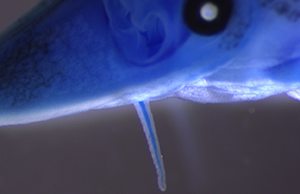Ancient genetic program employed in more than just fins and limbs
Hox genes provide blueprint for a diversity of body plan features, SF State researchers find
SAN FRANCISCO, Nov. 19, 2014 -- Hox genes are master body-building genes that specify where an animal's head, tail and everything in between should go. There's even a special Hox gene program that directs the development of limbs and fins, including specific modifications such as the thumb in mice and humans. Now, San Francisco State University researchers show that this fin- and limb-building genetic program is also utilized during the development of other vertebrate features.

This image shows a paddlefish barbel, a sensory organ, hanging below the fish's nostril in front of the eye. New research from SF State biologist Karen Crow shows that the barbel is patterned by the Hox gene program.
The discovery means this ancient genetic program is employed in a variety of features beyond fins and limbs. For instance, this Hox program helps to pattern the barbels in paddlefish -- sensory organs near the fish's mouth. In addition, the limb-building program had previously been observed in a cluster of genes called the HoxD genes. But SF State Associate Professor of Biology Karen Crow and her colleagues demonstrated for the first time that the program also operates in the HoxA cluster of genes during the development of the vent, a structure in all ray-finned fishes that is similar to a urethra, indicating that the regulation of this expression pattern is older and more widely utilized than thought.
Together, these new findings "really expand our view of this Hox limb-building program," said Crow. "Now we think it could be associated with all kinds of features that arise in different species."
"There is tremendous interest in animal diversity and how novel features arise in evolution," she added, "and we're just beginning to understand the genetic basis of morphological diversity."
Hox genes are the master regulatory genes that specify the identity and position of body parts during an animal's development. Hox genes are expressed at different times and places in the developing embryo, and that pattern of expression "acts like a code that sets up an address system for body parts," Crow explained.
One kind of Hox expression pattern establishes the "address" for the head-to-tail locations of body parts. But a reversal of this pattern, for some Hox genes, creates a code that specifies body parts that extend out away from the body, like fins, limbs or now even barbels or vents. Evolutionary biologists have been intensely interested in this limb-building program because it is part of the genetic basis of how fins evolved to become limbs, and how specialized structures arose in human evolution, such as the genetic code that specifies the thumb should be different from the other digits.
Researchers know that this limb-building program has operated at least since the origin of jawed vertebrates, some 440-480 million years ago. "So we wondered if this Hox repertoire is being utilized in all kinds of other features that people haven't yet looked at," said Crow.
Since discovering this particular Hox program in barbels and vents, Crow's lab has found the program operating in the development of claspers in skates and rays. They are now looking to see if the program helps direct the patterning of other appendages, like the manta ray's distinctively curled head fins, called cephalic lobes, or the brood structures where seahorses and pipefish carry their young.
"I think this genetic program is deployed in all kinds of vertebrate features that have yet to be discovered," Crow said. "We're just beginning to understand the underlying genetic basis of different structures in different animals. And, surprisingly, some aspects of those genetic instructions are shared."
"HoxA and HoxD expression in a variety of vertebrate body plan features reveals an ancient origin for the distal Hox program" by Crow, Sophie Archambeault and Julia Ann Taylor was published online Nov. 19 in the journal EvoDevo and can be viewed at http://www.evodevojournal.com/content/5/1/44/abstract. The study was supported by grants from the National Science Foundation.
###
SF State is the only master's-level public university serving the counties of San Francisco, San Mateo and Marin. The University enrolls nearly 30,000 students each year and offers nationally acclaimed programs in a range of fields -- from creative writing, cinema, biology and history to broadcast and electronic communication arts, theatre arts and ethnic studies. The University's more than 228,000 graduates have contributed to the economic, cultural and civic fabric of San Francisco and beyond.